The Bimal Jalan-panel on the economic capital framework of the RBI has proposed an April-March financial year for the apex bank against the current July-June year of the bank.
The economic capital framework report, which was released on Tuesday, wants the framework to be revised every five years. Besides, it wants interim dividend to be paid only under exceptional circumstances. On the basis of the report, the RBI on Monday had decided to transfer Rs 52,637 crore excess provisions to the government.
The committee has recommended the size of realised equity should cover the requirements of the contingent risk buffer (CRB) — sum of credit risk, operational risk and financial and monetary stability risks — as well as any shortfall in revaluation balances vis-à-vis the market risk tolerance limit (RTL).
Given that, as on June 30, 2018, there was no shortfall in revaluation balances, the size of the realised equity should be 6.5 per cent of the balance sheet, with a lower bound of 5.5 per cent.
On the treatment of excess realised equity, the committee said the excess realised equity as on June 30, 2018 ranges from Rs 26,280 crore — at upper bound of CRB — to Rs 62,456 crore, at lower bound of CRB. The excess realised equity as on June 30, 2019 will need to be determined on the basis of RBI’s finalised annual accounts for 2018-19 as well as the realised equity level .
The report said the available realised equity (ARE) — comprising capital reserve fund, contingency fund (CF) and asset development (ADF) — will be compared with the “requirement” to determine surplus distribution.
The entire net income shall be transferred to the government, if the RBI’s ARE is equal to or greater than upper bound of “requirement”. Subject to ARE lying within the range of “requirement”, the board may consider risk provisioning in a manner so as to maintain the RBI’s ARE within the range of “requirement”, till the next periodic review.
If ARE falls short of the lower bound of “requirement”, appropriate risk provisioning should be made by the RBI to augment the realised equity to the lower bound of “requirement” and only the residual net income (if any) should be transferred to the government.
If any risk provisioning from net income has been made previously for market risk, the excess realised risk provisioning over the target level of market risk buffers, may be reversed, the report said.










